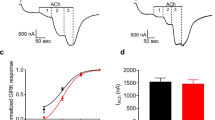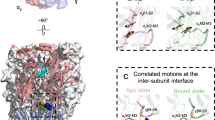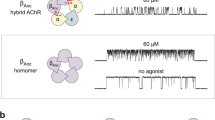Abstract
The primary structures of two muscarinic acetylcholine receptor (mAChR) species, designated as mAChR I and mAChR II, have been elucidated by cloning and sequence analysis of DNAs complementary to the porcine cerebral and cardiac messenger RNAs, respectively1–3. mAChR I and mAChR II expressed in Xenopus oocytes differ from each other both in acetylcholine-induced response and in antagonist binding properties1,4. These results, together with the differential tissue location of the two mAChR mRNAs1,2, have indicated that pharmacologically distinguishable subtypes of the mAChR represent distinct gene products. The primary structures of two additional mammalian mAChR species, designated as mAChR III and mAChR IV, have subsequently been deduced from the nucleotide sequences of the cloned cDNAs or genomic DNAs5–7. We report here that mAChR I and mAChR III expressed in NG108-15 neuroblastoma-glioma hybrid cells, but not mAChR II and mAChR IV, efficiently mediate phosphoinosi-tide hydrolysis, activation of a Ca2+-dependent K+ current and inhibition of the M-current, a voltage-dependent K+ current sensitive to muscarinic agonists.
This is a preview of subscription content, access via your institution
Access options
Subscribe to this journal
Receive 51 print issues and online access
$199.00 per year
only $3.90 per issue
Buy this article
- Purchase on Springer Link
- Instant access to full article PDF
Prices may be subject to local taxes which are calculated during checkout
Similar content being viewed by others
References
Kubo, T. et al. Nature 323, 411–416 (1986).
Kubo, T. et al. FBBS Lett. 209, 367–372 (1986).
Peralta, E. G. et al. Science 236, 600–605 (1987).
Fukuda, K. et al. Nature 327, 623–625 (1987).
Bonner, T. I., Buckley, N. J., Young, A. C. & Brann, M. R. Science 237, 527–532 (1987).
Peralta, E. G. et al. EMBO J. 6, 3923–3929 (1987).
Akiba, I. et al. FEBS Lett. 235, 257–261 (1988).
Nirenberg, M. et al. Science 222, 794–799 (1983).
Pennefather, P., Lancaster, B., Adams, P. R. & Nicoll, R. A. Proc. natn. Acad. Sci. U.S.A. 82, 3040–3044 (1985).
Brown, D. A. & Adams, P. R. Nature 283, 673–676 (1980).
Higashida, H. & Brown, D. A. Nature 323, 333–335 (1986).
Berridge, M. J. A. Rev. Biochem. 56, 159–193 (1987).
Kurose, H., Katada, T., Amano, T. & Ui, M. J. biol. Chem. 258, 4870–4875 (1983).
Yano, K., Higashida, H., Haltori, H. & Nozawa, Y. FEBS Lett. 181, 403–406 (1985).
Harden, T. K. et al. Trends pharmac. Sci. Suppl. 7, 14–18 (1986).
Ashkenazi, A. et al. Science 238, 672–675 (1988).
Peralta, E. G., Ashkenazi, A., Winslow, J. W., Ramachandran, J. & Capon, D. J. Nature 334, 434–437 (1988).
Nukada, T., Mishina, M. & Numa, S. FEBS Lett. 211, 5–9 (1987).
Higashida, H. et al. Brain Res. 214, 287–299 (1981).
Gorman, C. in DNA Cloning vol. II (ed. Glover, D. M.) 143–190 (IRL, Oxford, 1985).
Bone, E. A., Fretten, P., Palmer, S., Kirk, C. J. & Michell, R. H. Biochem. J. 221, 803–811 (1984).
Berridge, M. J., Dawson, R. M. C., Downes, C. P., Heslop, J. P. & Irvine, R. F. Biochem. J. 212, 473–482 (1983).
Thomas, P. S. Proc. natn. Acad. Sci. U.S.A. 77, 5201–5205 (1980).
Author information
Authors and Affiliations
Rights and permissions
About this article
Cite this article
Fukuda, K., Higashida, H., Kubo, T. et al. Selective coupling with K+ currents of muscarinic acetylcholine receptor subtypes in NG108-15 cells. Nature 335, 355–358 (1988). https://doi.org/10.1038/335355a0
Received:
Accepted:
Issue Date:
DOI: https://doi.org/10.1038/335355a0
This article is cited by
-
Cyclic ADP-ribose as an endogenous inhibitor of the mTOR pathway downstream of dopamine receptors in the mouse striatum
Journal of Neural Transmission (2018)
-
M1 muscarinic receptors block caspase activation by phosphoinositide 3-kinase- and MAPK/ERK-independent pathways
Cell Death & Differentiation (2000)
-
Muscarinic receptor functioning and distribution in the eye: Molecular basis and implications for clinical diagnosis and therapy
Eye (1999)
-
Involvement of protein tyrosine phosphatases in activation of the trimeric G protein Gq/11
Oncogene (1999)
-
Desensitization and resensitization of δ‐opioid receptor‐mediated Ca2+ channel inhibition in NG108‐15 cells
British Journal of Pharmacology (1998)
Comments
By submitting a comment you agree to abide by our Terms and Community Guidelines. If you find something abusive or that does not comply with our terms or guidelines please flag it as inappropriate.



